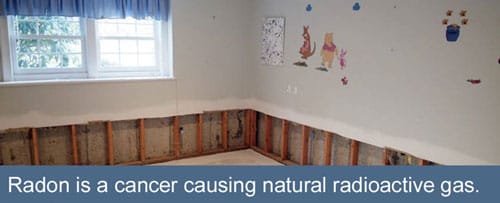Radon Gases in the Basement

Radon is an invisible and odorless radioactive gas and is continuously created by natural breakdown of metals in soils. Any home in any state may have a radon problem. The average person receives each year more radiation from radon than from all other source. Almost all risks come from breathing air with radon and its decayed products.
How Radon Gets into your Home and your Basement
Stack Effect – Air pressure inside homes (basements or crawl spaces) is slightly lower than in the ground creating a vacuum that draws in radon from several feet away into the basement through openings and pores in concrete. Warm air inside homes moves upward like inside a stack and this stack effect reduces air pressure in the basement. When the ground is soaked with rain, the bottled up radon gas in the ground moves to a warm opening such as a basement or crawlspace. This stack effect will cause a radon gas inflow that will easily migrate in to the home.
It’s important to know that the radon gases found in the basement are no different than the radon gases found in your home’s crawlspaces. While radon may be present in these two areas of the home, these two areas may simply have a different radon level concentration.
Concrete – Almost half of the water used in poured concrete mix is surplus and has to evaporate. Concrete cures and passes moisture to the surfaces creating a network of capillaries (pores). The pores allow a passageway for radon gases, water vapor, and liquid water to enter the basement.
Heavy radon gas accumulates in basements and on lower floors. According to the residential radon lung cancer study completed in Iowa, the 1st floor of a home receives 40% of its air from the basement level.
Effect of Radon Gases
Radon decaying products cause cancer. It is estimated that 12% of all lung cancers are caused by exposure to Radon gas. It is also estimated that 15,000 to 20,000 of the 158,000 lung cancer deaths per year in the United States are caused by exposure to Radon. Many years may pass before the effects of radon are detected.
How to Prevent Radon Gases
Minimize the entry of radon gas into your home by sealing cracks in the foundation and along the basement walls, floors, or molding. Cover all crawl spaces with a heavy polyethylene barrier and seal it to the foundation wall. Close sump pits and floor drains.

Rescon Basement Solutions does not provide radon gas remediation services.
Water Problems in the Basement
Mold and Mildew Problems
The Air You Breathe
Radon Gas in Basements


